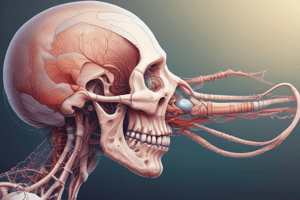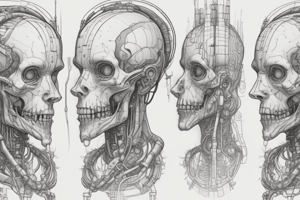Podcast
Questions and Answers
What is the total number of pharyngeal arches that develop by the end of the 4th week?
What is the total number of pharyngeal arches that develop by the end of the 4th week?
- 4
- 5
- 6 (correct)
- 3
Which pharyngeal arch develops into the maxilla and mandible?
Which pharyngeal arch develops into the maxilla and mandible?
- 2nd pharyngeal arch
- 4th pharyngeal arch
- 3rd pharyngeal arch
- 1st pharyngeal arch (correct)
What is the nerve associated with the 1st pharyngeal arch?
What is the nerve associated with the 1st pharyngeal arch?
- Trigeminal nerve (correct)
- Vagus nerve
- Facial nerve
- Glossopharyngeal nerve
Which pharyngeal arch develops into the stapes and styloid process?
Which pharyngeal arch develops into the stapes and styloid process?
What is the derivative of the 3rd pharyngeal arch?
What is the derivative of the 3rd pharyngeal arch?
What is the nerve associated with the 4th pharyngeal arch?
What is the nerve associated with the 4th pharyngeal arch?
What is the fate of the 4th pharyngeal arch?
What is the fate of the 4th pharyngeal arch?
What develops from the 2nd pharyngeal pouch?
What develops from the 2nd pharyngeal pouch?
What are the three components of the pharyngeal apparatus?
What are the three components of the pharyngeal apparatus?
What is the function of the pharyngeal clefts?
What is the function of the pharyngeal clefts?
Which pharyngeal pouch gives rise to the superior parathyroid gland?
Which pharyngeal pouch gives rise to the superior parathyroid gland?
During what week of embryonic development do the pharyngeal arches begin to develop?
During what week of embryonic development do the pharyngeal arches begin to develop?
What is the origin of each pharyngeal arch?
What is the origin of each pharyngeal arch?
What is the result of defects in the development of pharyngeal cleft 1?
What is the result of defects in the development of pharyngeal cleft 1?
What is the fate of the pharyngeal arches?
What is the fate of the pharyngeal arches?
What happens to the pharyngeal arches as they grow?
What happens to the pharyngeal arches as they grow?
What is the function of each pharyngeal arch?
What is the function of each pharyngeal arch?
By the end of which month are the major features of the external body form recognizable?
By the end of which month are the major features of the external body form recognizable?
Flashcards are hidden until you start studying
Study Notes
Pharyngeal Arches
- 1st pharyngeal arch appears at the beginning of the 4th week, and eventually, 5 arches form by the end of the 4th week, numbered 1, 2, 3, 4, and 6 (5th arch fails to form)
Characteristics of Pharyngeal Arches
- Each arch has muscle, skeletal, and neuronal components
- Components of each arch:
- 1st pharyngeal arch (mandibular arch)
- Muscles: muscles of mastication, mylohyoid, digastric (anterior belly), Tensor veli palatini
- Skeletal: Maxilla, Mandible, Malleus, and Incus
- Nerve: Trigeminal nerve
- 2nd pharyngeal arch (hyoid arch)
- Muscles: muscles of facial expression, Stylohyoid, digastric (posterior belly), Stapedius
- Skeletal: Stapes, Styloid process, Lesser horn of the hyoid bone
- Nerve: Facial nerve
- 3rd pharyngeal arch
- Muscles: Stylopharyngeus
- Skeletal: Greater horn of the hyoid bone
- Nerve: Glossopharyngeal nerve
- 4th pharyngeal arch
- Muscles: Cricothyroid muscle, All intrinsic muscles of the soft palate
- Skeletal: Thyroid cartilage, Parathyroid, Epiglottic cartilage
- Nerve: Superior laryngeal and the recurrent laryngeal branches of the Vagus nerve
- 6th pharyngeal arch (no. 6)
- Muscles: All intrinsic muscles of the larynx except the Cricothyroid muscle
- Skeletal: Cricoid cartilage, Arytenoid cartilage, Corniculate cartilage
- Nerve: Superior laryngeal and the recurrent laryngeal branches of the Vagus nerve
Pharyngeal Pouches
- 1st pharyngeal pouch: Forms the Eustachian tube, middle ear, and inner layer of the tympanic cavity
- 2nd pharyngeal pouch: Contributes to the development of palatine tonsils, pharyngeal tonsils, and lingual tonsils
- 3rd pharyngeal pouch: Develops into the inferior parathyroid gland and thymus
- 4th pharyngeal pouch: Develops into the superior parathyroid gland and C-Cells of the thyroid gland
Pharyngeal Clefts
- Ectodermal lined recesses that appear on the outside of the pharynx between the arches
- 1st pharyngeal cleft: Develops into the external auditory meatus
- Defects in the development of pharyngeal cleft 1 can result in preauricular cysts and/or fistulas
- Pharyngeal clefts 2, 3, and 4 are usually obliterated
Fate of Pharyngeal Arches
- The pharyngeal arches contribute exclusively to the formation of the face, nasal cavities, mouth, larynx, pharynx, and neck
- The pharyngeal apparatus is an embryological structure consisting of pharyngeal grooves or clefts (ectoderm), pharyngeal arches (mesoderm), and pharyngeal pouches (endoderm)
- During the 4th week of embryonic development, each of the three germ layers gives rise to a number of specific tissues and organs, and the major features of the external body form are recognizable by the end of the second month.
Studying That Suits You
Use AI to generate personalized quizzes and flashcards to suit your learning preferences.



